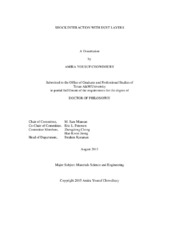| dc.description.abstract | Dust explosion hazards in areas where combustible dusts are found have caused loss of life and halted business operations in some instances. The elimination of secondary dust explosion hazards, i.e. reducing dust dispersion, can be characterized in shock-tubes to understand shock-dust interactions. For this reason, a new shock-tube test section was developed and integrated into an existing shock-tube facility. The test section has large windows to allow for the use of the shadowgraph technique to track dust-layer growth behind a passing normal shock wave, and it is designed to handle an incident shock wave up to Mach 2 to impersonate real-industry scenarios. The characterization experiments presented herein demonstrate the advantages of the authors’ test techniques toward providing new physical insights over a wider range of data than what have been available heretofore in the literature.
First, the effect of shock strength on the dust entrainment process was explored by subjecting limestone dust to Mach numbers ranging from 1.10 to 1.60. Also, the effect of dust-layer thickness on the entrainment process was observed by performing tests with two different layer depths, namely 3.2- and 12.7-mm thicknesses. New data were collected to develop correlations between the shock strength and the dust entrainment height as a function of time for each layer depth. The longer observation time and higher camera framing rates led to the discovery of trends not previously observed by earlier studies, such as a clear transition time between the early, linear growth regime and a much-slower, average growth regime. This second regime is however accompanied by surface instabilities that can lead to a much larger variation in the edge of the dust layer than seen in the early growth regime. In addition, for the linear growth regime, there was no significant difference in the dust-layer height growth between the two layer thicknesses; however, the larger thickness led to higher growth rates and much larger surface instabilities at later times. Next, we conducted experiments to elucidate the effect of particle size and size polydispersity on dust cloud formation phenomena behind blast waves. Through systematic modification of the span of the particle size distribution, the striking effect of polydispersity on the entrainment process was demonstrated. Moreover, correlations between linear dust rise rate and particle size and size polydispersity have been developed. Finally, recommendations for numerical modelers of this field and NFPA 654, Standard for the Prevention of Fire and Dust Explosions from the Manufacturing, Processing, and Handling of Combustible Particulate Solids are provided for developing a better dust explosion hazard assessment tool. | en |


